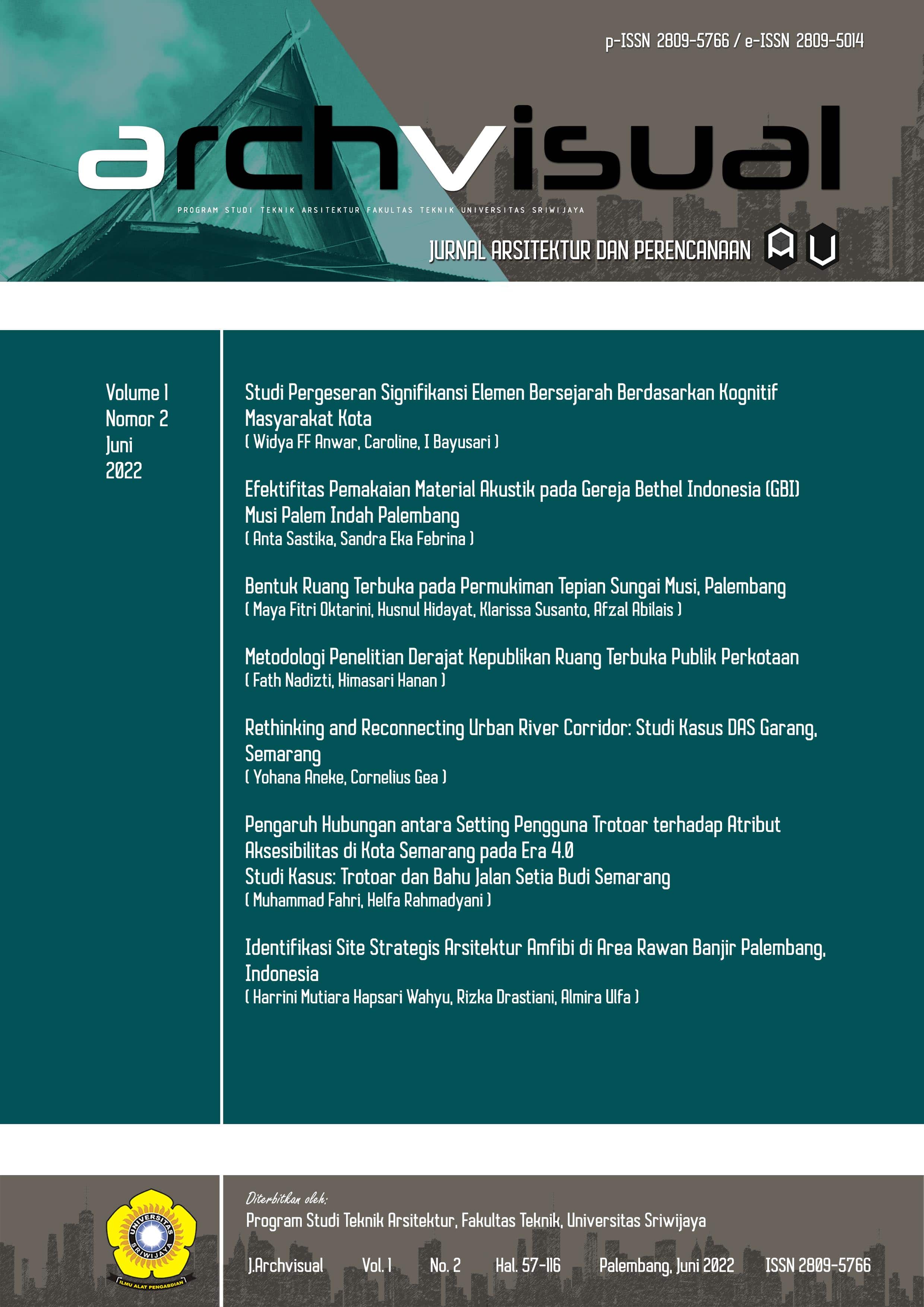Metodologi Penelitian Derajat Kepublikan Ruang Terbuka Publik Perkotaan
Main Article Content
Abstract
The degree of publicness is an approach to assessing the extent to which an open space is public. This approach has grown rapidly over the last twenty years, particularly in Europe and the United States. This article describes the dynamics and development of publicity research through a literature review. Eight scientific journals and one book were qualitatively reviewed using the content analysis method. This article finds that the key to the degree of publicity is adjusting the indicators to the context of the place and culture of an urban open space. In Indonesia, the cultural context of the city development process and local characteristics are two important things in the application of the degree of publicity approach.
Article Details
Section

This work is licensed under a Creative Commons Attribution-NonCommercial 4.0 International License.
How to Cite
References
Angel, Shlomo. (2011). Making Room for a Planet of Cities. Cambridge, MA: Lincoln Institute of Land Policy.
Banerjee, Tridib. (2001). “The Future of Public Space: Beyond Invented Streets and Reinvented Places.” Journal of the American Planning Association 67(1):9–24. doi: 10.1080/01944360108976352.
Carmona, Matthew, Claudio de Magalhães, & Leo Hammond. (2008). Public Space: The Management Dimension. London ; New York: Routledge.
Carr, Stephen, ed. 1992. Public Space. Cambridge [England] ; New York, NY, USA: Cambridge University Press.
Darmawan, Edy. (2005). “Ruang Publik Dan Kualitas Ruang Kota.” Seminar Nasional PESAT.
Darmawan, Edy. (2014). “Peranan Ruang Publik Dalam Perancangan Kota.” in Aneka gagasan begawan arsitek tentang arsitektur, urbanisme, dan perancangan kota, edited by E. Budihardjo. Bandung: Penerbit P.T. Alumni.
De Magalhães, Claudio. (2010). “Public Space and the Contracting-out of Publicness: A Framework for Analysis.” Journal of Urban Design 15(4):559–74. doi: 10.1080/13574809.2010.502347.
Edensor, Tim, & Mark Jayne, eds. (2012). Urban Theory beyond the West: A World of Cities. London ; New York: Routledge.
Ekdi, Fatma Pelin, & Hale Çıracı. (2015). “Really Public? Evaluating the Publicness of Public Spaces in Istanbul by Means of Fuzzy Logic Modelling.” Journal of Urban Design 20(5):658–76. doi: 10.1080/13574809.2015.1106919.
Firman, Tommy. (2004). “New Town Development in Jakarta Metropolitan Region: A Perspective of Spatial Segregation.” Habitat International 28(3):349–68. doi: 10.1016/S0197-3975(03)00037-7.
Florida, Richard L. (2012). The Rise of the Creative Class: Revisited. New York: Basic Books.
Habermas, Jürgen. (1991). The Structural Transformation of the Public Sphere. Cambridge, Massachusetts: The MIT Press.
Hsieh, Hsiu-Fang, & Sarah E. Shannon. (2005). “Three Approaches to Qualitative Content Analysis.” Qualitative Health Research 15(9):1277–88. doi: 10.1177/1049732305276687.
Kohn, Margaret. (2004). Brave New Neighborhoods. New York, NY: Routledge.
Landry, Charles. (2000). The Creative City: A Toolkit for Urban Innovators. London: Earthscan Publications.
Madanipour, Ali. (2003). Public and Private Spaces of the City. London ; New York: Routledge.
Madanipour, Ali, ed. (2010). Whose Public Space?: International Case Studies in Urban Design and Development. Abingdon, Oxon ; New York: Routledge.
Mboup, Gora, Rasna Warah, & United Nations Human Settlements Programme. (2013). Streets as Public Spaces and Drivers of Urban Prosperity.
Németh, Jeremy. (2012). “Controlling the Commons: How Public Is Public Space?” Urban Affairs Review 48(6):811–35. doi: 10.1177/1078087412446445.
Németh, Jeremy, & Stephen Schmidt. (2011). “The Privatization of Public Space: Modeling and Measuring Publicness.” Environment and Planning B: Planning and Design 38(1):5–23. doi: 10.1068/b36057.
Sorkin, Michael, ed. (1992). Variations on a Theme Park: The New American City and the End of Public Space. 1st ed. New York: Hill and Wang.
Stemler, Steve. (2000). “An Overview of Content Analysis.” Practical Assessment, Research, and Evaluation 7(17). doi: 10.7275/Z6FM-2E34.
UN Habitat. (2015). Habitat III Issue Paper 1 - Inclusive Cities. UN Habitat.
UN Habitat. 2015. Habitat III Issue Paper 11 - Public Spaces. UN Habitat.
Van Melik, Rianne, Irina Van Aalst, & Jan Van Weesep. (2007). “Fear and Fantasy in the Public Domain: The Development of Secured and Themed Urban Space.” Journal of Urban Design 12(1):25–42. doi: 10.1080/13574800601071170.
Varna, George, & Steve Tiesdell. (2010). “Assessing the Publicness of Public Space:The Star Model of Publicness.” Journal of Urban Design 15(4):575–98. doi: 10.1080/13574809.2010.502350.
Varna, Georgiana. (2014). Measuring Public Space: The Star Model. Farnham, Surrey, UK ; Burlington, VT: Ashgate.
Varna, Georgiana, & Damiano Cerrone. (2013). “Making the Publicness of Public Spaces Visible: From Space Syntax to the Star Model of Public Space.” EAEA-11 Coference.

